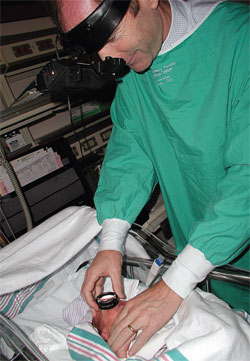 |
|
Data shows there is a demand for more pediatric ophthalmologists. Click image to enlarge. |
A new study in JAMA Ophthalmology accessed information from the public databases of American Academy of Ophthalmology and American Association for Pediatric Ophthalmology and Strabismus to identify current pediatric ophthalmologist distribution in the US as of March 2022.
Researchers found a total of 1,056 practicing pediatric ophthalmologists, with the highest concentrations in the four most populous states of California (11.0%), New York (9.2%), Florida (6.5%) and Texas (5.9%). Concerningly, 90.0% of all US counties and four states (8.0%) had zero pediatric ophthalmologists. The range of practitioner to million persons has grown in disparity since last data was obtained in 2007, despite a moderate increase in number of practitioners (300) since that time.
Those counties with one or more pediatric ophthalmologists displayed higher median household income than counties without any. Even further, the percentage of families without internet access, persons younger than 19 years without health insurance and households without a vehicle were all higher in counties with no pediatric ophthalmologists when compared with counties that had at least one.
Based especially on the expanding discrepancy between practitioner to million persons, the authors of the study endorse that “these results support the need to improve incentive structures to redistribute pediatric ophthalmologist resources to match the unequal health burden in underserved counties.”1 As a possible solution, they suggest introducing the field to individuals who are interested either before entering ophthalmology residency or even before going into the medical field, bringing attention to high school and college students. They cite that this could work because evidence has found that students introduced to niche specialties earlier are more invested in them long-term.
What the authors of the study can agree on is the importance of these findings, as “the aforementioned factors all can have marked implications for patients’ ability to seek and consistently access both virtual and in-person pediatric ophthalmological care, which may be exacerbated by the lack of available local practitioners evidenced in this study.”1
With the study outlining well what shortcomings currently exist in the US population demographically, as related to pediatric ophthalmology, an invited commentary in the same issue of JAMA Ophthalmology further refines the information and takes a more nuanced approach to analyzing the study trends.
The authors of the commentary highlight the importance of economic viability concerns with the occupation. This includes lengthy and complex examinations for children, meaning pediatric ophthalmologists see less patients, thus resulting in lower reimbursement than ophthalmologists seeing only adults. They also point out the fact that it is a seller’s market, with this profession able to select their location practice, since the number of professionals is small. As a result, physicians have been shown to choose areas that already see high patient volume, thus the underserved areas remain vulnerable to access.
The commentary authors do make sure to add, “However, while the authors suggest a notion of incentivizing the redistribution of the existing pool of pediatric ophthalmologists to more underserved areas, the more significant problem appears to be the astonishing scarcity of total pediatric opthalmologists.”2 They further elaborate that two-thirds of American counties would remain unfilled if all pediatric ophthalmologists were evenly distributed, one by one, across all counties.
Despite this disagreement, the commentary echoes the same sentiment toward the general findings of the study as the original authors do: “We should dedicate resources to the development of pediatric ophthalmology fellowship programs in geographically underserved areas and provide economic incentives for those willing to remain there after training.” This, as well as potential legislative reform to allow for cross-state coverage, could be the first steps to reversing the issue.
1. Walsh HL, Parrish A, Hucko L, Sridhar J, Cavuoto KM. Access to pediatric ophthalmological care by geographic distribution and US population demographic characteristics in 2022. JAMA Ophthalmol. January 26, 2023. [Epub ahead of print]. 2. Oatts JT, Indaram M, de Alba Campomanes AG. Where have all the pediatric ophthalmologists gone?—Pediatric eye care scarcity and the challenge of creating equitable health care access. JAMA Ophthalmol. January 26, 2023. [Epub ahead of print]. |


